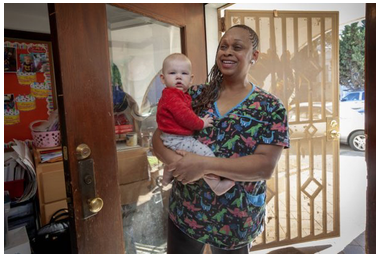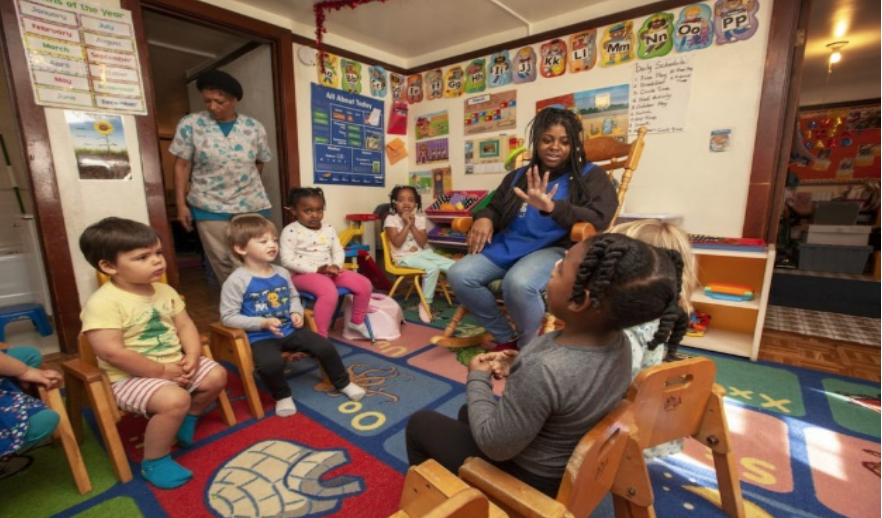CommentsEDUCATION POLITICS--The assembled 2- to 4-year-olds are halfway through a lesson about walking slowly, not rolling around on the floor when a teacher is talking, and how to identify different parts of the body (the “tummy” is a big hit), when a piercing wail comes from upstairs.
“That’s my little Sam,” says Nancy Harvey, the owner of Lil’ Nancy’s Primary Schoolhouse in West Oakland. “Sam…he keeps us going.” (Photo above: At Lil Nancy's Primary Schoolhouse. At left are teachers Yolanda Wilson and Kyla Kinner. Photo by Penni Gladstone for CALmatters)
Sure enough, Sam, who is being watched by one of “Miss Nancy’s” assistants in the infant room upstairs, is fussing. Though happy enough to squirm around on the carpet and practice his crawling skills, he is failing to embrace nap time.
Learning to sleep when you’re tired can be a challenge if you’re less than 12 months old. Teaching a dozen children to nap, read and make friends every day for 15 years might be even harder.
.Of this crop of preschoolers—nine in the classroom plus three toddlers napping (or not) upstairs—four come from families who are receiving state assistance. And that ties Harvey’s financial fortunes to the political and budgetary vagaries of Sacramento.
“I cannot offer a livable wage because the reimbursements are so low,” she said of her three aides. “Women and men in this field don’t have decent retirement. Many don’t have anything. I don’t have anything.”
So Harvey, a small business owner, is hoping to join forces with an unlikely ally: organized labor.
 A bill introduced by Assemblywoman Monique Limón, a Democrat from Santa Barbara, would allow self-employed child care workers who serve subsidized families to collectively bargain with the state. Included in this new class of organized laborers would be trained workers like Harvey, but also unlicensed friends, family and neighbors who parents turn to when they are out of other options. Together, these at-home providers are responsible for more than one-third of the young children who attend subsidized daycare—and a larger share of toddlers and infants.
A bill introduced by Assemblywoman Monique Limón, a Democrat from Santa Barbara, would allow self-employed child care workers who serve subsidized families to collectively bargain with the state. Included in this new class of organized laborers would be trained workers like Harvey, but also unlicensed friends, family and neighbors who parents turn to when they are out of other options. Together, these at-home providers are responsible for more than one-third of the young children who attend subsidized daycare—and a larger share of toddlers and infants.
Child care is prohibitively expensive for even middle-class families in much of California. At the same time, the majority of the workers who care for the state’s youngest children are paid so little they qualify for public assistance themselves, according to one estimate. Now, with the state coffers flush, many providers are pushing for this bill—along with a whole slew of child care related legislation aimed at making things easier for families and providers alike.
But whether the state can improve conditions for workers without taking away resources meant for poor families—and whether a union is the best way to achieve that goal—is a hot question. It’s sparked pushback from foes of organized labor, who label the idea a union power grab, and could even earn the skepticism of some child care advocates.
Mary Gutierrez, a campaign director with the Service Employees International Union sponsoring the bill, insists that collective action is the “most effective tool” to get policymakers to pay attention to a low-paid workforce, made up mostly of women of color.
“It’s a commitment by the state to actually sit down with you and listen to what you have to say about the decisions that are being made,” she said.
Those decisions include the rates that the state pays to reimburse subsidized child care workers, access to training and—maybe one day—benefits. Any spending increases would still need to be approved by the Legislature, but at least the state government would be forced to listen to the union’s concerns, said Gutierrez.
Letting family care home providers negotiate directly with the state is an idea that has been introduced at least nine times in Sacramento—only to be vetoed or buried in committee.
With new governor Gavin Newsom, who made early childhood education a thrust of his campaign, advocates are hoping the tenth time is the charm.
“This is a new era,” said Limón. “We have a new governor who cares a lot about child care.”
Lawmakers are considering a series of other proposals that would pump more funding into the state subsidy program, simplify the way that providers are paid and expand access to pre-school.
Earlier this week, a commission on early childhood education put together by Assembly Speaker Anthony Rendon released a draft report recommending the state “support collective bargaining rights” for at-home child care workers.
Some of the sharpest critics of the proposal come from those who are wary of the political power of unions.
The National Right to Work Committee, an anti-organized labor group, called Limón’s bill “a union power grab” designed to induce child care providers into financially supporting the Service Employees International Union.
The bill would allow the state to automatically deduct union membership dues from the subsidies it pays to providers who volunteer, although a recent U.S. Supreme Court ruling would make it illegal to collect dues from workers who do not wish to belong to the union. Still, the Right to Work Committee warned that “providers are frequently misled into signing dues deduction cards that are then automatically funneled to the union.”
Critics have been particularly outraged by the proposal to let unlicensed caregivers organize. One Republican state senator derided a previous version of the bill as a bid to “unionize baby-sitters, including grandma, grandpa and the teen down the street saving for college.”
But over the last 15 years, the chief political stumbling block in Sacramento has not been anti-union sentiment, but cost.
“Increases in family child care provider reimbursement rates, expanded provider training efforts, or other program enhancements could come at the expense of the number of available child care slots,” Gov. Schwarzenegger wrote in 2008 veto message. Even some child care advocates opposed that earlier bill for the same reason, worried that given a fixed amount of state and federal funding for child care, higher payments to providers per child would come at the expense of the families that those providers serve.
The Learning Policy Institute estimated that two-thirds of children whose families qualify for subsidized child care don’t receive it—a result, they argue, of insufficient state funding already.
Even the author of the bill acknowledges that the best solution would be to boost funding for child care across the board so workplace improvements for providers don’t come at the expense of the families they serve.
“If there’s going to be an investment in the number of slots” available for children from low-income families, said Limón, “that ought to go hand in hand with quality childcare. They’re not necessarily mutually exclusive.”
Other advocates argue that providing more support for child care workers could entice more workers into the industry—or keep them from leaving. Though data for at-home workers are not available, the average annual wage for all child care workers in California is $27,670.
“You’ve got to really love children to want to work a job that pays about the same as animal trainers,” said Deborah Stipek, an education researcher at Stanford. “And we have an economy now with a very low unemployment rate, so people have alternatives that are better paid.”
Advocates point out that at-home child care providers are not even covered by minimum wage guarantees. The reason: they aren’t workers, but self-employed business owners. Some providers, like Harvey, even have employees of their own, who wouldn’t be part of a future union.
Despite falling unionization rates nationwide, the SEIU has had some success convincing legislatures and courts to let them organize independent contractors. In 1999, Los Angeles County home healthcare workers who are paid by the state joined the union. That’s been called “the biggest organizing victory for the U.S. labor movement” since the 1940s.
Bringing child care workers into the unionized fold in California could be a comparable coup. While at-home child care workers have been organized in 11 other states, organizing small business owners is still unfamiliar terrain for organized labor, said Gutierrez.
“It’s a new thing for us,” she said.
(Ben Christopher writes for CalMatters … where this piece was first posted.)
-cw
















